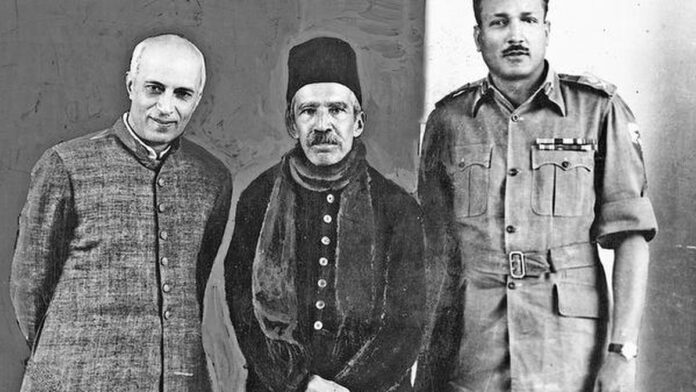
Jawaharlal Nehru with Nizam Mir Osman Ali Khan and Maj. Gen. J.N. Chaudhuri after the police action.
| Photo Credit: THE HINDU
While a new controversy is raging in Karnataka about Tipu Sultan, contested claims are being made on the borders of Telangana too.
Speaking in a village of Bidar district on March 26, Home Minister Amit Shah said that there was ‘hesitation’ on the part of the Telangana government to celebrate Hyderabad Liberation Day. The next day, the Telangana government’s social media team cited media reports to contest Mr. Shah’s claim. Information Technology Minister K.T. Rama Rao said that the Telangana government had celebrated Telangana National Integration Day on September 17 last year. He tweeted: “To those who ask why can’t we call it Liberation Day; Why do we celebrate 15th August as Independence Day and not as Liberation Day? What should matter is respectful commemoration of the sacrifices & struggles against oppressors; be it the British or Nizam (sic).”
The controversy brings to light the fraught history of the Hyderabad region. Mr. Shah’s speech indicates that the stakes are high for the Bharatiya Janata Party (BJP) in both the southern States. The Bharat Rashtra Samiti (BRS) was quick to respond to the Home Minister’s claims as it is seeking to expand its footprint beyond Telangana and want to guard their turf in the State.
When Mr. Shah spoke at Gorta B village in Karnataka, he shared the dais with Telangana BJP chief Bandi Sanjay and MLA Etala Rajender. Raichur, Bidar and Gulbarga are the three districts in Karnataka which were part of the erstwhile Nizam’s Dominion. The end of Nizam’s rule in the region and its aftermath was one of the most traumatic events in the history of the region.
This is the area that bore the brunt of the violence unleashed by the Razakars, the volunteers of the Majlis e-Ittehadul Muslimeen party which backed the Nizam in the days preceding Operation Polo, the military action to integrate Hyderabad with India. In Gorta B village, where Mr. Shah spoke, more than 100 people were killed, most of them Hindus, according to eyewitness accounts shared with journalists. There was terror in the region again when soldiers of the Indian Army defeated the Nizam’s Army in a 109-hour war. Most of the civilians killed were Muslims.
The Confidential Notes of the Sunderlal Committee Report that investigated the aftermath of the merger of Hyderabad into India makes for grim reading. “The total number of people killed in Gulbarga district must have been between 5,000 and 8,000… The district of Bidar fared at least as ill as if not worse than Gulbarga,” it states. The violence in the region before and after the day of merger on September 17, 1948, was noted by the mandarins in Delhi. K.M. Munshi, India’s Agent-General in Hyderabad, and other Congressmen released a stream of information about the ground reality that crystallised Indian Army action. Once the Nizam’s forces surrendered, there was a sigh of relief at the upper echelons of the polity. There was no triumphalism. Privately, there was a sigh of relief that the Hyderabad action did not trigger communal conflagration across India.
“With our success in Hyderabad, we have removed one great source of potential mischief in the communal sphere,” wrote the then Home Minister, Sardar Vallabhbhai Patel, in a letter. A similar sentiment was expressed by Prime Minister Jawaharlal Nehru: “Recently, events in Hyderabad have not only gone a long way to solve our Hyderabad problem but have also had a most beneficial result in the whole situation in India. The communal situation has improved tremendously.”
Many of the actions of the then government fighting a ghost war in Kashmir were dictated by realpolitik, an understanding of social and communal dynamics, and facts on the ground. But the perceptions of the people in the three different regions of the Nizam’s Dominion were different. In the districts in Maharashtra, citizens began celebrating Marathwada Mukti Sangram. In the three districts of Karnataka, they celebrated Kalyana Karnataka Liberation Day. In contrast, the event was marked in a muted manner in erstwhile Andhra Pradesh and later in Telangana. Only the communist parties that were part of the Telangana armed struggle celebrated the day, not the state machinery. Last year, the Telangana government celebrated Telangana National Integration Day.
This contested history will only get more fraught as Telangana begins to prepare for elections.
#Fact #fiction #nomenclature #Hindu
